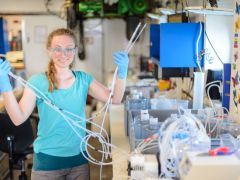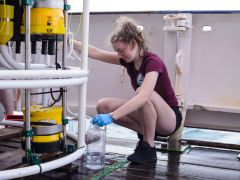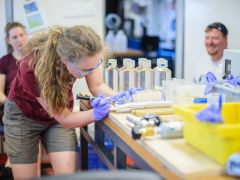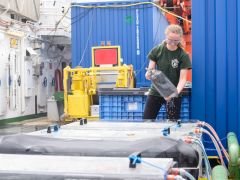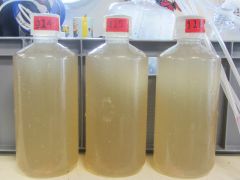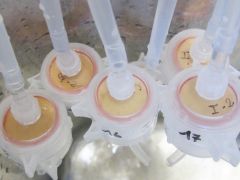
Ocean interfaces under global changes –
Exploring the fate of the Amazon River plume
13.05.2021 – The hunt for phytoplankton
After you have learned how we chose our daily stations with the help of satellite images in the last entry, it is time for some more detailed insights into our daily work on board R/V Meteor.
I have successfully fought my way out of the “tubing jungle” (meaning my filtration set up for sea water – more details below) to explain my research project to you. My work consists of a lot of filling bottles from the CTD, adding stuff to it, putting them under running sea water for a few hours and the filtering the particles out of the water. Life on board is such that I am getting soaked by splashing incubators, when I put my samples into them and fighting against pump tubing that seems to take my stubborn hair as a role model and starts to get more and more entangled during the day instead of staying well aligned (see pictures below…). I also have to win the race against time quite often, as terminations of experiments keep adding up and always seem to end at exactly the same time, even though I had planned otherwise. Working at sea requires quite a lot of flexibility, but however stressful it can get – it is also a lot of fun and our labs are filled with laughter, which might or might not have to do a lot with the combination of 80’s music and lots (lots!) of caffeine ;-)…Anyway, back to topic!
We are now going to zoom in from space to the upper layer of the ocean – the home of phytoplankton. As you might remember from our first entry, phytoplankton are microscopic algae, capable of photosynthesis (the conversion of sunlight to energy). But not all phytoplankton species are alike, of course. Most of them, like for example diatoms and dinoflagellates, rely on nitrate, ammonium or dissolved organic nitrogen in surrounding waters as a nutrient source necessary for growth. In contrast, nitrogen fixers (so-called diazotrophs) provide new nitrogen to the rest of the phytoplankton community. They are independent of other nitrogen sources in the water, as they can fix their nitrogen from the atmosphere (N2). However, for their photosynthesis all tiny algae need sunlight and are therefore restricted to the upper, sunlit - only roughly 100m thick layer - of the ocean – the so called euphotic zone.
In the Amazon River plume, the conditions for phytoplankton are very special. The river water has a lower salinity than the ocean water, hence it is lighter (that’s physics now, let’s not go into too much detail about this here ;-)). This freshwater lens floats on top of the oceanic water and only mixes with it very slowly. Therefore, phytoplankton can either get trapped in the river water or stays below where it can be light limited in its growth, as the river water is quite turbid (remember, turbidity is what helps us track the plume). Like phytoplankton, nutrients from deeper water layers also can’t reach the surface plume layer and the algae are limited by nitrogen and phosphorus (both required for growth). Near the river mouth and near the coast, this limitation is not as strong as further north, where nitrogen and phosphorus become more and more scarce.
These nutrient poor conditions favour a very special group of phytoplankton organisms, the DDAs (Diatom-Diazotroph associations). They live especially in the northern plume area and at its eastern edge, almost in the Caribbean where the plume is still well identifiable. DDAs are beautiful diatoms, they have wonderful shells made of slilica and they are living in symbiosis with nitrogen fixing (diazotroph) symbionts. All diatoms need silicate, which is still available in the older plume regions. On top of that the nitrogen fixing symbiont supplies ammonium for their growth. Most other phytoplankton species are not able to live in these waters because of the limiting nitrogen concentrations. So symbiosis is a good thing even for these small creatures.
Because of the change in nutrient concentrations and the light limitation, the Amazon River plume thus shapes different phytoplankton communities as the plume travels northwards. The different phytoplankton communities are first limited by light, then by nitrate, and in the end the nitrogen fixers dominate. I want to study this exciting sequence of phytoplankton for my PhD.
Now comes another aspect of all this, may be it is for specialists only, but I want to let you know nevertheless. Depending on the nitrogen source used by phytoplankton, primary production can be referred to as new or regenerated production. New production is fuelled by nitrogen fixers that use gaseous N2 from the atmosphere or by the uptake of nitrate that is delivered to the euphotic zone from external sources (like rivers or the upwelling of subsurface water). Regenerated production comes from the uptake of remineralised biomass within the euphotic zone. I measure growth of phytoplankton based on either of these nutrient sources, nitrate and ammonium. Nobody has done it before! Moreover, nobody has understood the productivity of the Amazon plume region, and it is time to study this thoroughly with my incubations.
I am measuring the uptake rates of nitrate, ammonium and amino acids (a form of dissolved organic nitrogen, DON). The way to do so is to use nitrogen labelled with 15N (the heavy isotope of nitrogen, as you might remember from blog entry 2): Step one is to collect water from the CTD rosette from different depths (where light is available for photosynthesis). This water is then enriched with 15N and 13C (we call that « spiking with a tracer ») and incubated for 2 to 4 hours. To simulate the light intensity at the depth from which the sample was collected, we put our bottles in mesh bags that match the respective light intensity. The bottles are then placed in incubators on deck. To avoid heating of the samples because of the sunshine, the incubators are continuously flooded with surface seawater. During the incubation, the phytoplankton in the water takes up the added 15N-nitrogen and 13C-carbon. This way, the tracers are integrated in the bodies of the small algae. After incubation, the phytoplankton is collected onto filters and can later be analysed in the laboratory with a mass spectrometer.
Back at home in Warnemünde, I will find how many nutrients have been consumed. With the mass spectrometer, we analyse the heavy and the light isotopes in the phytoplankton. From the data I can calculate how much of the 15N and 13C was taken up by the plankton and Tadaa, there are my uptake rates!
Now I will continue sampling and filtering and hope I don’t get entangled in all the tubing – if I am still lost in two months, you now have an idea where to look for me…
Cheers!
Text: Umbricht J., Voss M. (all IOW) | click pictures to enlarge
| Expedition: | M174 |
| Mission: | MeNARP |
| Start: | 12.04.2021 - Las Palmas |
| Destination: | 31.05.2021 - Emden |
